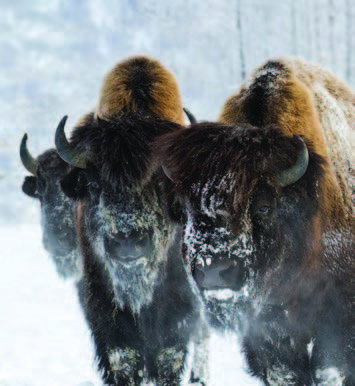Wood bison head home again – for first time in 100 years
By Lana Johnson, Vice Chair, AWCC Board
Next March, C-130s will depart for Shageluk, returning the first herd of wood bison to the grasslands they roamed for tens of thousands of years before the massive animals disappeared around the turn of the century. The freedom flight will be the crowning effort of a 20-year project one biologist describes as the “most significant Alaskan conservation initiative of this century.”
The largest land mammal in the Western Hemisphere, wood bison lived in Alaska for most of the last 5,000 to 10,000 years. Athabaskans relied on them for food, clothing and shelter until they disappeared in the early 1900s, probably due to unregulated hunting and changes in habitat distribution. A few bison survived in Canada and thanks to Canadian protection laws, today there are approximately 5,000 healthy wood bison in several herds in Northwest Territories, Yukon, British Columbia, Alberta and Manitoba.
The Alaska Department of Fish and Game (ADF&G) kicked off the effort to bring these magnificent animals back to Alaska more than 20 years ago. In 2008 ADF&G received 53 young wood bison from Elk Island National Park in Alberta. Those animals were added to 13 other wood bison obtained by Alaska Wildlife Conservation Center (AWCC) in 2003. Thus began the joint commitment between ADF&G and AWCC to raise, care for, and prepare wood bison for release.
Mike Miller, AWCC’s Executive Director, explained that the center’s role is “to take care of these animals and grow their numbers until they can be released into the wild. It’s a mission we take seriously because we want to tell our grandchildren how we helped Alaska restore an asset from the past.”
The 2015 release will occur in the Lower Innoko/Yukon River area, approximately 300 air miles west of Anchorage. The release area offers excellent habitat and ongoing support from the local communities.
The first release was delayed for months as the state and federal government worked out the details of a special rule making the wood bison a nonessential experimental population under the Endangered Species Act (ESA). The rule, called the 10(j) Rule, was finally published in the Federal Register last May. The rule means that no critical habitat will be set aside even through the animals are listed as “threatened” under the ESA. This is important because the reintroduction will not impede oil and gas development, mining, recreation, hunting, trapping and other land uses.
Wood bison are larger than plains bison and a mature bull will weigh as much as 2,250 pounds, versus 1,900 pounds for a plains bison. A mature cow will weigh about 1,000 pounds. Most calves are born in May and are a reddish color for a few weeks. They begin to grow horns and develop a bison’s “hump” at about two months.
Some Athabascan terms for the animal mean cow in the forest, and the hefty one on the land. Athabascan oral history describes how they were hunted in Interior Alaska with spears, snowshoes, and bow and arrow for hides and meat.
The wood bison restoration project, which state wildlife planner Rita St. Louis describes as “the most significant Alaskan conservation initiative of this century,” is supported by groups such as the Wildlife Conservation Society and Safari Club International, as well as some key businesses, including Lynden, Totem Ocean Trailer Express, Wells Fargo, Granite Construction, ConocoPhillips and Carlile Transportation Systems.
“This historic project is a collaborative effort that brings together hunters, government agencies, environmental groups and the business community,” AWCC’s Miller said. There’s much more on this project at www.alaskawildlife.org.

Wood bison are larger than plains bison and a mature bull will weigh
as much as 2,250 pounds, versus 1,900 pounds for a plains bison.

The largest land mammal in the Western Hemisphere, wood
bison lived in Alaska for most of the last 5,000 to 10,000 years.
Return to newsletter headlines